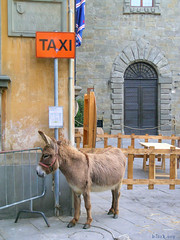wingsuit base jumping from Ali on Vimeo.
Tag: Tuscany things to do
Lucca Jazz Donna 2009, 21-28 February
Coincidentally enough at the press conference for this the 5th edition of Lucca Donna Jazz, held in the Headquarters of the patrons Fondazione Banca del Monte, the conversation spontaneously turned to this era of Lucca Jazz.
The board members reminisced their teenage pilgrimages to San Giorgio in the hope of a few notes from Chet’s last partner Ruth Young sang at the 2006 edition of the festival.
So don’t miss this week of top class concerts taking place in the San Girolamo Theatre starting February 21st and presented by famous TV music personalità and DJ Claudio Sottili. Thi is the 2009 Lucca Jazz Donna Festival organized by the Circolo Lucca Jazz, dedicated this year to Billie Holiday on the 50th anniversary of her death.
As a side event the 1984 Emmy and Bafta award winning film Billie Holiday – The Long Night of Lady Day by Jhon Jeremy will be shown at the Cinema Centrale on Thursday 19th February.
The festival aims to bring female jazz musicians to the forefront, whether they sing, play, compose or arrange jazz music. Two mid-week evenings are dedicated to the 2009 Award for young talent and feature, six female groups from Rome, Palermo, Puglia, Milan and Lucca.
The weekend events in Lucca feature Michele Hendricks, daughter of Jon of legendary trio Lambert, Hendricks and Ross, Eileina Dennis from the US with her gospel background and hit recording with Randy Crawford and Zucchero, Tiziana Ghiglioni known as La Signora del Jazz Italiano and the captivating voice of Ada Montellanico with her guest Max Ionata.
A special tribute to Billie Holiday entitled Our Way to Lady Day will take place at Teatro Alfieri in Castelnuovo Garfagnana on March 27th with the Ricciardi/Premazzi Quartet.
previous edition have hosted dramme Kim Thompson, just on the cusp of fame, saxophonist Lisa Pollard and violinist Regina Carter, to name a few.
The festival is a showcase for Lucca to be proud of, adding sparkle and International glamour to the town during the drab low season of february. Spread the word!
Last year these shows were a sell-out so we recommend you buy tickets in advance from Telerecord, Via Santa Croce 11/13. On sale from 10th february. More info regarding the programme and tickets at www.luccajazzdonna.it; segreteria-eventi@comunelucca.it
Tel. +39 0583.442444, or centro.po@provincialucca.it Tel. +39 0583 433435
Listening also in What’s On Central pages.
Tuscan Taxi, to don’t miss!

Tuscan Taxi
Inserito originariamente da blork
Tuscan Taxi, to don’t miss!
Casale Sodini Perks, Meeting with the Artists in Pierasanta
Casale Sodini is proud to offer you the chance to savour – “Meeting with the Artists in Pietrasanta”.
Book the Villa during January 2009 for a stay at any time in 2009 and we’ll include “Meeting with the Artists in Pietrasanta” program of event at no extra cost!
This enchanting medieval town, so beloved to very renowed sculptors as Mitoraj, Botero, Cascella, Finotti, Capotondi, Rhon, Gamundi, Heppe, etc. , will be the special meeting point where spending a delightful and unforgettable day. This chance is not to be missed! It is an opportunity reserved to few and lucky people who love to be in touch with the “sculptor’s closest world”. Realise a work of art is always an intimate process for the artist and he is sometimes very jealous about his works, but we are allowed to this unique, incredible experience.
To start our trip, it is a pleasure for us to welcome you in Duomo Square (one of the most beautiful square in the world) around 10 o’ clock, 10:30 a.m.
We immediately reach the artist’s studio/workshop. The artist waits for us, as an old, kind friend, just to disclose his secrets and show us how his sculpture was born. Behind a creation there is always an hard work, lot of passion and affliction till the last day, when the work is finished and the artist finally feels a great joy and forgets the agony.
A fine collection of bronzes take the same care and attention, in order to see statues made of bronze, we will visit a foundry, where we could feel again the same charm as before. The artist, as an intimate friend, will gladden us sharing the “pleasures of the table”.
We can choose a characteristic restaurant in the countryside, or one of the many restaurants on the beach breathing the sweet smell of the sea and eating fresh fish. The inevitable conclusion is a toast to celebrate this wonderful day together.
Tuscany Trouffle season! Heaven can wait…
You’d think they were giving them away to witness the annual stampede to specialty restaurants and gourmet shops up and down the Italian peninsula where customers become positively unruly elbowing each other out of the way to get served first.
On the contrary, the divinely pungent white truffles of Piedmont and Tuscany are practically worth their weight in gold. In season, fresh, first quality truffles will easily fetch 3,000 to 4,000 euros a kilo, and it takes just one taste of a risotto or omelet dressed with shavings of white truffle to acquire a lifelong unbating passion for this shy tuber.
Truffle worship is not a new phenomenon – the ancients considered these delectable comestibles to be the “undisputed king of the table” and, better still, a potent aphrodisiac. In their writings, such luminaries as Pliny the Elder, Pythagoras, Epicurus, Plutarch and Nero waxed ecstatic over them.
Alexandre Dumas once declared that if a truffle could speak it would say, “ Eat me and adore God.”
No wonder there has been chronic skullduggery and backroom brawls among truffle hunters over the centuries.
Though recently formed professional associations have established standards, required hunter sto be licensed and keep a tight control over prices in order to eliminate disputes and other unpleasantries, each year the newspeapers carry shocking stories of hunting dogs being poisoned or other crimes of violence or intimidation in truffle country.
For all the hoopla surrounding them, truffles are a most unassuming plant. Potato – like in shape, they are a subterranean fungus which grows on the roots of poplar, linden, oak and hazelnut trees. They can bea s small as a walnut or as large as a grapefruit.
There are said to bea s many as seventy varieties throughout Europe, from Portugal to the Czech Republic, and they can even be found in North Africa and Sardinia. Entrepreneurs have long attempted to develop techniques for commercial cultivation, such as inoculatine soil with fungus spores, but the secrets of the symiotic relationship between the tuber and its host tree and the surrounding conditions continue to elude them and they have met with only limited success.
As it has been throughout history, durino the months of November through January when truffles reach their peak aroma and maturità, it still remains for the truffle hunter and his four – legged companion to forage in the wild, through forest, over hill and dale, in search of the elusive truffle. Traditionally, especially in France, it was the farmer’s pig on a leash who hunted the truffles, with the farmer in hot pursuit. When the pig started rooting in the soil to get at the subterranean treasure, the farmer would drag the pig away bifore it had time to consume the precious tuber and then he would finish the digging.
Nowadays, for the most part, the pigs have been replaced by well-trained trufflehunting dogs who are happy with only a dog biscuit as a reward. Of all the truffle varieties, the two most prized are the black Tuber Melanosporum pound primarily in France and the white Tuber Magnatum found i the Piedmont and Tuscan regione of Italy.
Surprisingly, the two are vastly different in every aspect, not just color. The black truffle, whose outer skin sometimes has a honeycomb-like texture, has a mild but distinct aroma and nutty flavor. It is almost always marinated or cooked and then added to patés, terrines or the classic Périgourdine sauce.
White truffles, on the other hand, have a smooth outer skin and an intoxicatingly strong, distinct, some would say, primal aroma. I’ve been told it is againts the law to carry them on public transportation in Italy. White truffles should never be cooked. They are shaved raw over cooked risotto, pasta, omelets, cheese fonde, Florentine steaks, cannellini beans and other vegetables.
Gourmet alimentari and butcher shops in Lucca, and hill towns such as Volterra and San Miniato al Tedesco ( which are the prime Tuscan areas for truffle hunting) offer for sale wonderful truffled pecorino cheese, fresh truffled pork sausage, fresh ravioli pasta filled with ricotta cheese and truffles butter. ( From personal experience, I do not recommend prepackaged jars of truffled butter or truffled olive oil. )
Many of restaurants in and around Volterra and san Miniato al Tedesco offer unforgettable truffle meals.
When purchasing fresh white truffles, be sure to choose ones that are firm to the touch with a distinct aroma. Spongy truffles, be sure to choose ones that are firm to the touch with a distinct aroma. Spongy truffles, like spongy potatoes, are too old. Fresh truffles are cleaned by brushing them lightly with a soft brush or soft cloth.
They should not be washed unless coated with dirt. Fresh truffles have a short shelf life – they should be washed unless coated with dirt. Fresh truffles have a short shelf life – they should be consumed within a week of purchase. If not eaten immediately, wrap the truffle in kitchen toweling, seal in a glass jar and place in the vegetable crisper of the refrigerator. White truffles are sliced paper thin with a handheld tool known as a tagliatartufi , usually available at truffle fairs, gourmet shops or kitchen specialty storse.
Buon Appetito!



